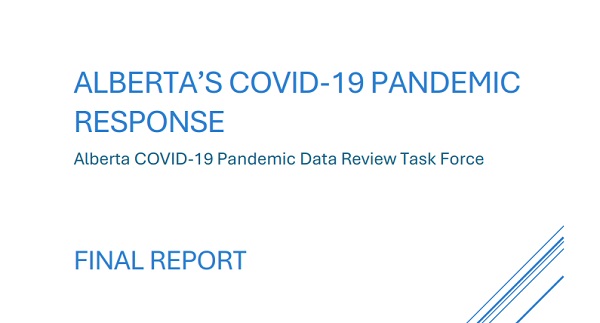Alberta
The Davidson Report critiquing the Government of Alberta’s COVID-19 pandemic response finally released: Dr David Speicher


Courageous Truth
Scientific facts, personal views and life’s journey
The Dr. Gary Davidson report has finally been released by the Government of Alberta and confirms big problems with public health and provides a roadmap for managing future pandemics.
Nearly six months after Dr. Gary Davidson’s report was submitted to Premier Danielle Smith, it was publicly released quietly by the Government of Alberta on their website.

The only public statement about the report was on Eric Bouchard’s X account: “Dr. Gary Davidson’s report brings Alberta one step closer to the truth. https://open.alberta.ca/publications/albertas-covid-19-pandemic-response”. Eric followed up by saying “Alberta now has a tremendous opportunity to right many of the wrongs that took place over the last few years. We must work together to heal humanity and to earn back the trust of all Albertans.” and “I am committed to working with Albertans to ensure that the historical pain caused by the response to COVID-19 does not repeat. Thank you, Dr. Davidson, for your incredible work to get this report out. I look forward to hearing Dr. Davidson live on March 3, 2025.”

Purpose:
On November 14, 2022, the Premier of Alberta established a Task Force under the Health Quality Council of Alberta to examine the quality, use, interpretation, and flow of information and data that informed Alberta’s pandemic response to COVID-19 and provide recommendations on how to better manage a future pandemic.
This report critiques the Government of Alberta’s response to the COVID-19 pandemic between 2020 and 2022. The report addresses 9 areas: governance and flow of information, regulatory bodies (e.g. the role of the College of Physicians and Surgeons of Alberta), modelling, non-pharmaceutical interventions, masking, testing, infection-acquired immunity, vaccines, and therapeutics. The task force attempted to remain neutral and examine information on both sides of the narrative. However, there was a “fundamental lack of transparency and willingness to reveal information and discuss decisions and actions taken by AHS during the pandemic.” and the task force found that there was “a lack of willingness on the part of AHS officials to cooperate with the Task Force in our requests for data and information.” [Pg 40-41]
Chapter 6: Testing
As a molecular virologist with expertise in the detection and surveillance of infectious diseases, the task force asked me to provide information and guidance on PCR, rapid antigen testing (RAT), and serological testing for SARS-CoV-2/COVID-19 during the pandemic. The report provides excellent background and the methods used to test people for SARS-CoV-2.
Unfortunately, I continue to see misinformation spread about the reliability of the PCR test, including the number of cycles and “97% false-positives”. Therefore, I will be providing a deep dive into the PCR test over the coming weeks, including presenting insight on one legal case where I served as an expert witness that asked whether or not a PCR test for COVID is a “genetic test” according to the Ontario labour code. I would be happy to answer any questions that people may have.
From The Davidson Report, I would like to highlight two key issues. The first is the classification of a COVID case being determined by a PCR-positive test result driving a “casedemic” rather than a “pandemic” and the second is regarding the millions of dollars wasted on unused PCR reagents and RATs.


It is important to note the following recommendations made regarding testing (P174):
- RT-PCR represents an excellent high-sensitivity test to aid in accurate diagnoses of symptomatic people – if they are used for the intended purpose and at optimal Ct values (vs. Ct values at “high positive” cut-offs).
- Rapid tests with reasonable accuracy should not be used for screening the general population but could be used as an additional diagnostic tool, where clinically indicated.
- We recommend that future pandemic responses prioritize minimizing severe disease and mortality over extensive case detection. Specifically, Alberta should focus on developing a screening tool to help estimate individual risk. This approach will optimize resource use by directing testing capacity, which can be appropriately directed by evidence-based practices, such as testing symptomatic individuals, those whose management may be influenced by test results, and for specific surveillance scenarios.
- We recommend that levels of immunity be gauged using a multi-antibody serological and/or mucosal assay that accounts for both pre-existing immunity as well as the presence of immune cells with the potential for cross-protection.
- All tests should also be professionally administered and sufficiently sensitive to detect low antibody levels while sufficiently specific to distinguish between target and non-target antibodies. This also applies to laboratory tests used to identify specific respiratory viruses. Individual risk estimates can then be used to inform individual needs for protection either through the use of personal protective measures and/or vaccination.
- Without being linked to a set of standardized clinical criteria, we recommend against the use of PCR tests as the sole criteria for a case definition. A confirmed case should include a pre-determined profile of signs and/or symptoms AND a positive test for the infection of concern PLUS any relevant patient history and confirmed epidemiological information.
- Ensure that local surveillance data are used and interpreted when determining strategy and policy.
Final Thoughts
Regarding the report, I think that it is a very well-written critique of the Government of Alberta’s response to the COVID-19 pandemic, but it is not a final conclusive report. This is a good start to opening the door for some important deep governmental discussions that need to happen, including diving deeper into the harms caused by the COVID-19 modRNA vaccines, like the DNA contamination and the presence of the SV40 promoter-enhancer nuclear localization sequences, the vast number of vaccine-injured people, and the increased risk of turbo cancer. While I am disappointed that the Government of Alberta, namely Premier Smith, tried to bury this report by sitting on it for six months and quietly releasing the report without a proper press conference on the week of the USA inauguration I am relieved to see that the report was finally made public. The government’s attempt to bury the report shows that this is indeed a damning report and the government’s response could have been much better. However, I hope that this report will bring about government transparency and begin that well-needed conversation so that our society can indeed heal.
Healing Humanity is the theme of the next An Injection of Truth happening on March 3, 2025 in Calgary, Alberta. During the event I will be sharing on the numerous ways the COVID-19 vaccines can potentially cause harm and what can be done to heal from those harms. I will share the stage with several other prominent scientists.
- Dr. Byram Bridle who has also shared his insights on The Davidson Report and will be “exposing lies from public health agencies that contributed to a myriad of problems within the pandemic response.”
- Dr. Gary Davidson will be presenting on the contents the report by the Alberta COVID-19 Pandemic Data Review Task Force.
- Dr. Denis Rancourt will provide a deep dive into the all-cause mortality.
- Dr. David Martin will definitely be a presenter that no one will want to miss.
In closing, I encourage everyone to read through The Davidson Report and post your thoughts on the report in the comments section. What did you like or disagree with? What would you like to see different next time? I would be happy to take your comments to Calgary in March 2025. I also hope that this will be one of many governmental task forces that take a deep dive into the governmental response to the pandemic. We desperately need one for each province and at the federal level.

Alberta
Alberta’s grand bargain with Canada includes a new pipeline to Prince Rupert

From Resource Now
Alberta renews call for West Coast oil pipeline amid shifting federal, geopolitical dynamics.
Just six months ago, talk of resurrecting some version of the Northern Gateway pipeline would have been unthinkable. But with the election of Donald Trump in the U.S. and Mark Carney in Canada, it’s now thinkable.
In fact, Alberta Premier Danielle Smith seems to be making Northern Gateway 2.0 a top priority and a condition for Alberta staying within the Canadian confederation and supporting Mark Carney’s vision of making Canada an Energy superpower. Thanks to Donald Trump threatening Canadian sovereignty and its economy, there has been a noticeable zeitgeist shift in Canada. There is growing support for the idea of leveraging Canada’s natural resources and diversifying export markets to make it less vulnerable to an unpredictable southern neighbour.
“I think the world has changed dramatically since Donald Trump got elected in November,” Smith said at a keynote address Wednesday at the Global Energy Show Canada in Calgary. “I think that’s changed the national conversation.” Smith said she has been encouraged by the tack Carney has taken since being elected Prime Minister, and hopes to see real action from Ottawa in the coming months to address what Smith said is serious encumbrances to Alberta’s oil sector, including Bill C-69, an oil and gas emissions cap and a West Coast tanker oil ban. “I’m going to give him some time to work with us and I’m going to be optimistic,” Smith said. Removing the West Coast moratorium on oil tankers would be the first step needed to building a new oil pipeline line from Alberta to Prince Rupert. “We cannot build a pipeline to the west coast if there is a tanker ban,” Smith said. The next step would be getting First Nations on board. “Indigenous peoples have been shut out of the energy economy for generations, and we are now putting them at the heart of it,” Smith said.
Alberta currently produces about 4.3 million barrels of oil per day. Had the Northern Gateway, Keystone XL and Energy East pipelines been built, Alberta could now be producing and exporting an additional 2.5 million barrels of oil per day. The original Northern Gateway Pipeline — killed outright by the Justin Trudeau government — would have terminated in Kitimat. Smith is now talking about a pipeline that would terminate in Prince Rupert. This may obviate some of the concerns that Kitimat posed with oil tankers negotiating Douglas Channel, and their potential impacts on the marine environment.
One of the biggest hurdles to a pipeline to Prince Rupert may be B.C. Premier David Eby. The B.C. NDP government has a history of opposing oil pipelines with tooth and nail. Asked in a fireside chat by Peter Mansbridge how she would get around the B.C. problem, Smith confidently said: “I’ll convince David Eby.”
“I’m sensitive to the issues that were raised before,” she added. One of those concerns was emissions. But the Alberta government and oil industry has struck a grand bargain with Ottawa: pipelines for emissions abatement through carbon capture and storage.
The industry and government propose multi-billion investments in CCUS. The Pathways Alliance project alone represents an investment of $10 to $20 billion. Smith noted that there is no economic value in pumping CO2 underground. It only becomes economically viable if the tradeoff is greater production and export capacity for Alberta oil. “If you couple it with a million-barrel-per-day pipeline, well that allows you $20 billion worth of revenue year after year,” she said. “All of a sudden a $20 billion cost to have to decarbonize, it looks a lot more attractive when you have a new source of revenue.” When asked about the Prince Rupert pipeline proposal, Eby has responded that there is currently no proponent, and that it is therefore a bridge to cross when there is actually a proposal. “I think what I’ve heard Premier Eby say is that there is no project and no proponent,” Smith said. “Well, that’s my job. There will be soon. “We’re working very hard on being able to get industry players to realize this time may be different.” “We’re working on getting a proponent and route.”
At a number of sessions during the conference, Mansbridge has repeatedly asked speakers about the Alberta secession movement, and whether it might scare off investment capital. Alberta has been using the threat of secession as a threat if Ottawa does not address some of the province’s long-standing grievances. Smith said she hopes Carney takes it seriously. “I hope the prime minister doesn’t want to test it,” Smith said during a scrum with reporters. “I take it seriously. I have never seen separatist sentiment be as high as it is now. “I’ve also seen it dissipate when Ottawa addresses the concerns Alberta has.” She added that, if Carney wants a true nation-building project to fast-track, she can’t think of a better one than a new West Coast pipeline. “I can’t imagine that there will be another project on the national list that will generate as much revenue, as much GDP, as many high paying jobs as a bitumen pipeline to the coast.”
Alberta
Alberta Premier Danielle Smith Discusses Moving Energy Forward at the Global Energy Show in Calgary

From Energy Now
At the energy conference in Calgary, Alberta Premier Danielle Smith pressed the case for building infrastructure to move provincial products to international markets, via a transportation and energy corridor to British Columbia.
“The anchor tenant for this corridor must be a 42-inch pipeline, moving one million incremental barrels of oil to those global markets. And we can’t stop there,” she told the audience.
The premier reiterated her support for new pipelines north to Grays Bay in Nunavut, east to Churchill, Man., and potentially a new version of Energy East.
The discussion comes as Prime Minister Mark Carney and his government are assembling a list of major projects of national interest to fast-track for approval.
Carney has also pledged to establish a major project review office that would issue decisions within two years, instead of five.
-

 Business19 hours ago
Business19 hours agoCarney’s European pivot could quietly reshape Canada’s sovereignty
-

 Alberta18 hours ago
Alberta18 hours agoAlberta’s grand bargain with Canada includes a new pipeline to Prince Rupert
-

 Crime1 day ago
Crime1 day agoManhunt on for suspect in shooting deaths of Minnesota House speaker, husband
-

 Bruce Dowbiggin3 hours ago
Bruce Dowbiggin3 hours agoWOKE NBA Stars Seems Natural For CDN Advertisers. Why Won’t They Bite?
-

 Energy3 hours ago
Energy3 hours agoCould the G7 Summit in Alberta be a historic moment for Canadian energy?
-

 Crime3 hours ago
Crime3 hours agoMinnesota shooter arrested after 48-hour manhunt
-

 conflict4 hours ago
conflict4 hours ago“Evacuate”: Netanyahu Warns Tehran as Israel Expands Strikes on Iran’s Military Command
-

 Aristotle Foundation45 mins ago
Aristotle Foundation45 mins agoThe Canadian Medical Association’s inexplicable stance on pediatric gender medicine



